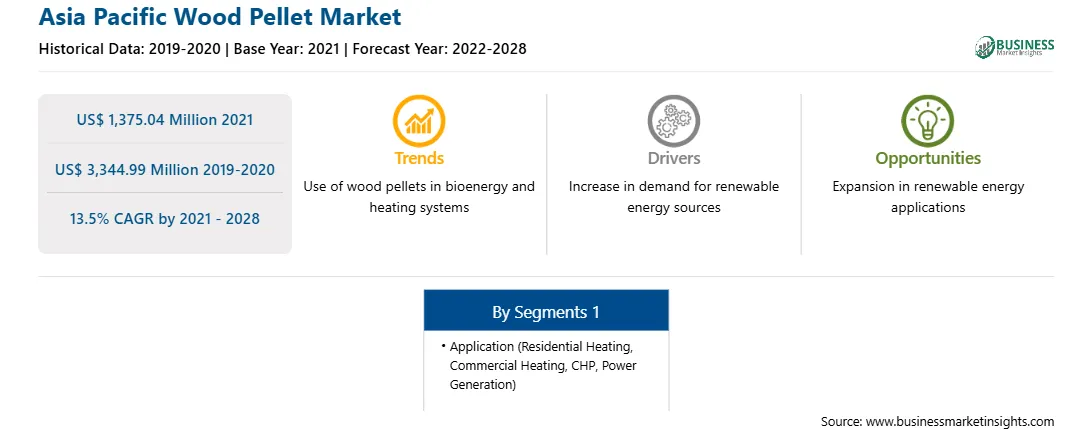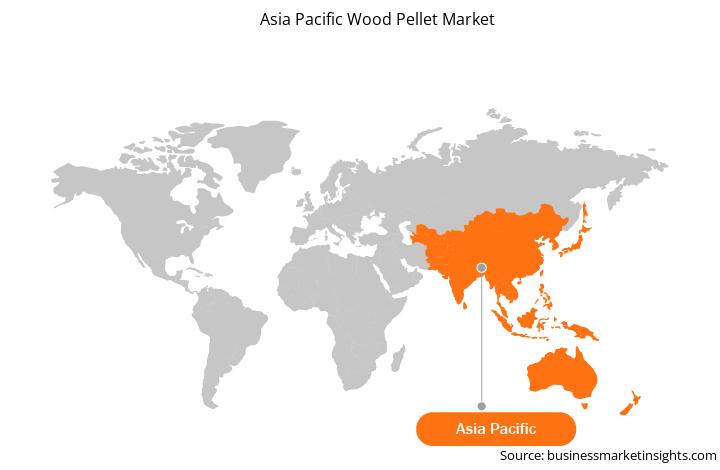The wood pellet manufacturing industries in Japan, India, China, South Korea, Singapore, Taiwan, and Indonesia are growing at a significant rate. Rising industrialization and urbanization in these countries offer ample opportunities for the key market players. The wood pellet industry in APAC countries has experienced a considerable shift over the years. The massive market growth in the region is attributed to the rising investments in sustainable and bio-based solutions in economies, such as India and China. Furthermore, favorable government policies attract new and international players to set their wood pellet manufacturing plants across China, India, and Japan. Asia Pacific holds strong potential numerous opportunities for new suppliers. In a few countries such as South Korea, Japan, and Vietnam, the demand for wood pellets is rising considerably due to the growing focus on renewable energy sources. For instance, for the past five years, the amount of wood pellets import has increased in South Korea. In 2016, the dependency on biomass-based operations was from 1.5 million to 1.8 million metric tons per year. Similarly, the government of Japan aims to expand its pipeline of wood pellets to support biomass plants. Other APAC countries, such as Indonesia, Malaysia, and Thailand, hold great potential for increased production of wood pellets. These countries have attractive sources of supply wherein the manufacturing capabilities can be effectively explored and expanded using a mixture of roundwood, residues from wood processing industries, and other residue sources such as rubberwood plantations. With the rising focus on renewable energy sources, the expansion of biomass-consuming power plants is scheduled in Japan and South Korea, which would ultimately generate the demand for wood pellets across the region.
The COVID-19 pandemic is anticipated to cause a significant economic loss to APAC. The Asian economies have been hit hard due to the pandemic. India has recorded the highest number of cases (31,855,783 cases with 426,785 deaths as of August 2021). The emergence of new COVID-19 waves in India, Thailand, and other Asian economies have prolonged the effect of pandemic upon GDP. The pandemic has been disrupting the growth of various industries in APAC. Furthermore, uncertainty regarding the future outbreak, especially in India and few other Asian countries, has seriously affected the performance of the industrial sector. These conditions have resulted in reduced demand for wood pellet. However, the market is expected to witness a surge in investments by existing players along with the entry of new players to cater to escalating demand in post-pandemic period.

Strategic insights for the Asia Pacific Wood Pellet provides data-driven analysis of the industry landscape, including current trends, key players, and regional nuances. These insights offer actionable recommendations, enabling readers to differentiate themselves from competitors by identifying untapped segments or developing unique value propositions. Leveraging data analytics, these insights help industry players anticipate the market shifts, whether investors, manufacturers, or other stakeholders. A future-oriented perspective is essential, helping stakeholders anticipate market shifts and position themselves for long-term success in this dynamic region. Ultimately, effective strategic insights empower readers to make informed decisions that drive profitability and achieve their business objectives within the market.

| Report Attribute | Details |
|---|---|
| Market size in 2021 | US$ 1,375.04 Million |
| Market Size by 2028 | US$ 3,344.99 Million |
| Global CAGR (2021 - 2028) | 13.5% |
| Historical Data | 2019-2020 |
| Forecast period | 2022-2028 |
| Segments Covered |
By Application
|
| Regions and Countries Covered | Asia-Pacific
|
| Market leaders and key company profiles |
The geographic scope of the Asia Pacific Wood Pellet refers to the specific areas in which a business operates and competes. Understanding local distinctions, such as diverse consumer preferences (e.g., demand for specific plug types or battery backup durations), varying economic conditions, and regulatory environments, is crucial for tailoring strategies to specific markets. Businesses can expand their reach by identifying underserved areas or adapting their offerings to meet local demands. A clear market focus allows for more effective resource allocation, targeted marketing campaigns, and better positioning against local competitors, ultimately driving growth in those targeted areas.

The wood pellet market in APAC is expected to grow from US$ 1,375.04 million in 2021 to US$ 3,344.99 million by 2028; it is estimated to grow at a CAGR of 13.5% from 2021 to 2028. Growing awareness about use of renewable energy sources; renewable energy plays a vital role to play in meeting the future energy needs in both rural and urban areas. The scarcity of resources, along with an increase in awareness about adverse environmental impacts of fossil-based products and processes, has surged the dependency on renewable energy sources such as wood pellets. The growing need for sustainable energy development is yet another factor contributing to the increased demand for wood pellets. Renewable energy resources and technologies are considered as environment-friendly alternatives as they generally cause limited or no impact on the environment than other forms of energy sources. Further, such resources are easily available and cannot be depleted. Wood pellets are categorized under renewable energy sources as they are derived from trees and are a form of biomass. Wood pellets are composed of dried and compressed wood fibers prepared from sawmill residuals, logging debris such as forest debris piles, and whole logs. Similarly, wood pellets are also considered as an efficient and cost-effective alternative source of energy that can be effectively deployed in numerous application bases. Hence, the demand for wood pellets is expected to rise with the growing investment in renewable energy forms. This is bolstering the growth of the wood pellet market.
Based on application, the market is segmented into residential heating, commercial heating, CHP (combined heat and power), and power generation. In 2020, the residential heating segment held the largest share APAC wood pellet market.
A few major primary and secondary sources referred to for preparing this report on the wood pellet market in APAC are company websites, annual reports, financial reports, national government documents, and statistical database, among others. Major companies listed in the report are ANDRITZ, Enviva Lp, Pinnacle Renewable Energy Inc, and TANAC among others.
The Asia Pacific Wood Pellet Market is valued at US$ 1,375.04 Million in 2021, it is projected to reach US$ 3,344.99 Million by 2028.
As per our report Asia Pacific Wood Pellet Market, the market size is valued at US$ 1,375.04 Million in 2021, projecting it to reach US$ 3,344.99 Million by 2028. This translates to a CAGR of approximately 13.5% during the forecast period.
The Asia Pacific Wood Pellet Market report typically cover these key segments-
The historic period, base year, and forecast period can vary slightly depending on the specific market research report. However, for the Asia Pacific Wood Pellet Market report:
The Asia Pacific Wood Pellet Market is populated by several key players, each contributing to its growth and innovation. Some of the major players include:
The Asia Pacific Wood Pellet Market report is valuable for diverse stakeholders, including:
Essentially, anyone involved in or considering involvement in the Asia Pacific Wood Pellet Market value chain can benefit from the information contained in a comprehensive market report.